Recently Published
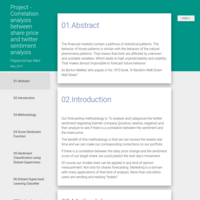
Stock prediction through Twitter sentiment analysis & Natural Language Processing
Our forecasting methodology is: To analyze and categorize the twitter sentiment regarding Daimler company (positive, newtral, negative) and then analyze to see if there is a correlation between the sentiment and the share price.
The benefit of this methodology is that we can receive the tweets real time and we can make our corresponding corrections on our portfolio
If there is a correlation between the daily price change and the sentiment score of our target share, we could predict the next day’s movement.
Of course our models here can be applied in any kind of opinion measurement. Not only for shares forecasting. Marketing is a domain with many applications of that kind of analysis. More than one billion users are sending and reading “tweets”
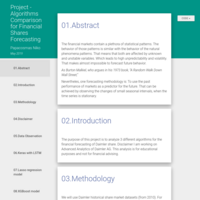
Algorithms Comparison for Stock Forecasting
# 03.Methodology
<br>
We will use Daimler historical share market datasets (from 2010). For forecasting future
values. On those nature of forecasting we assume that some patterns of our sets
have carriage on future short linear interims. The same approach is applied on
the weather forecasting.
We will apply mathematical technical indicators in our datasets on the below domains:
-**Support & resistance**
-**Trend**
-**Momentum**
-**Volume**
-**Volatility**
Some of them are the:
-**Moving average convergence/divergence**
-**Relative strength index**
-**Stochastic oscillator**
-**Ease of movement**
-**Larry Williams oscilator. Etc.**
The 3 algorithms that will we compare to predict the Daimler financial share
behavior are:
-(LASSO) Least Absolute Shrinkage and Selection Operator. This method is based
on a linear regression model is proposed as a novel method to predict financial
market behavior
-Deep Learning (Long Short Term Memory Neural Network of linear
stack densely connected layers.
-And eXtreme Gradient Boosting
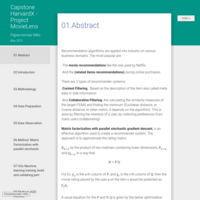
capstone harvardx project movielens
The purpose of this R project is to create a **rating recommender system through machine learning training.**
That recommender system will be able to predict a users rating into a new movie. Or the user preference for a
movie.
Many algorithms and data transformations where applied in order to achieve the lowest RMSE.
Such us:
-**Matrix Factorization with parallel stochastic gradient descent**
-**H2o stacked ensembles of (GBM,GLM,DRF,NN)**
-**H2o Deep Learning (Neural Networks)**
-**H2o Gradient Boosting Machine (GBM)**
-**H2o Auto ML**
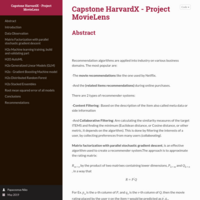
capstone movielens harvardx project
capstone movielens harvardx project in r
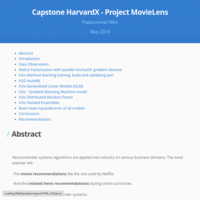
movielens
harvardx capsone movielens project recommender rating movies h2o